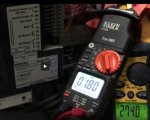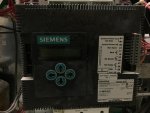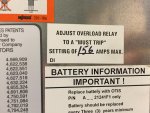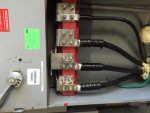Is the poco xfmr sized big enough or is the otis soft start not soft enough?
POCO came out with a RVM for a week and says they are good, there is no problem, this is never more than 5% drop.
When the elevator starts, and only when the elevator starts, and always when the elevator starts.... the lights dim globally at the 6 unit apt bldg
owners want to fix it.
Seems to me either the motor is drawing more than the poco xfmr can handle - altho poco says the 5% is ok - I have clamped 7-8% instantaneously on my old fluke and me new klein
either the motor needs a softer start or the poco xfmr is not stiff enough
the elevator is rated 156A
50hp at 230v 156amps
there's even a note in the can that says adjust overload relay to a "must trip" on 156a Max
I clamp 275a!
6 unit bldg has a 600a main
I measured at the mains and at the disco - always the same
at either end of the wire
giant inrush of 250/275a and 5%+ sag in voltage.
Elevator says they have a soft start on there, but I dont want to really go into the menu and see how they have it dialed in.
POCO says they are within tolerance.
I am just supposed to find the fault.
I would like to see proof of the soft start - is starting as soft as possible for this motor.
I would like to see the RVM readings that show it never dips below 5%
I didn't see any loose connections at the covers I did pull off. Impedance was pretty good generally at nearby outlets i did measure
Questions:
1. is it a stiffness question for the poco - but they wont admit it seems like
2. Would a properly co-ordinated soft start still have a 256a inrush on a 156a load?
3. If there were load calcs including the 156a elevator on this 6 unit apt bldg - it seems like half the capacity of the main is devoted to the elevator [all 6 units have small elec baseboard htrs, gas range, common dryer and 80a feeds]
Is there any chance the main was under sized to the poco and they connected up a load to big for their xfmr? Still a poco thing
I guess the load calcs are next




POCO came out with a RVM for a week and says they are good, there is no problem, this is never more than 5% drop.
When the elevator starts, and only when the elevator starts, and always when the elevator starts.... the lights dim globally at the 6 unit apt bldg
owners want to fix it.
Seems to me either the motor is drawing more than the poco xfmr can handle - altho poco says the 5% is ok - I have clamped 7-8% instantaneously on my old fluke and me new klein
either the motor needs a softer start or the poco xfmr is not stiff enough
the elevator is rated 156A
50hp at 230v 156amps
there's even a note in the can that says adjust overload relay to a "must trip" on 156a Max
I clamp 275a!
6 unit bldg has a 600a main
I measured at the mains and at the disco - always the same
at either end of the wire
giant inrush of 250/275a and 5%+ sag in voltage.
Elevator says they have a soft start on there, but I dont want to really go into the menu and see how they have it dialed in.
POCO says they are within tolerance.
I am just supposed to find the fault.
I would like to see proof of the soft start - is starting as soft as possible for this motor.
I would like to see the RVM readings that show it never dips below 5%
I didn't see any loose connections at the covers I did pull off. Impedance was pretty good generally at nearby outlets i did measure
Questions:
1. is it a stiffness question for the poco - but they wont admit it seems like
2. Would a properly co-ordinated soft start still have a 256a inrush on a 156a load?
3. If there were load calcs including the 156a elevator on this 6 unit apt bldg - it seems like half the capacity of the main is devoted to the elevator [all 6 units have small elec baseboard htrs, gas range, common dryer and 80a feeds]
Is there any chance the main was under sized to the poco and they connected up a load to big for their xfmr? Still a poco thing
I guess the load calcs are next




Last edited:

